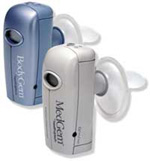Microlife MedGem And BodyGem Metabolism Basics
The Microlife BodyGem or MedGem indirect calorimeters measure Resting Metabolic Rate.
What Is Metabolism?
Metabolism is the biochemical process of combining nutrients with oxygen to release the energy our bodies need to function. Metabolism is typically measured in kilocalories or, more commonly, calories.
Total metabolic rate represents the calories needed for maintaining body functions, daily activity (occupational and lifestyle), and the energy cost of exercise or planned activity.
What is RMR?
Resting metabolic rate (RMR) represents the calories the body burns to maintain vital body functions (heart rate, brain function, breathing).
In simple terms, it is the number of calories a person would burn if they were awake, but at rest all day. RMR can represent up to 75% of a person’s total metabolism if they are inactive or lead a sedentary lifestyle.
Why is it necessary to measure RMR?
Since RMR accounts for up to 75% of the total calories we need each day, it’s a critical piece of information to appropriately establish daily calorie needs, whether we’re trying to lose or maintain weight.
Most healthcare and fitness professionals recognize that metabolism is impacted by a variety of characteristics such as fever, illness, high fitness, obesity, active weight loss, etc. When managing a client or patient’s nutritional needs and calorie requirements, knowledge of RMR is critically important.
Traditionally, healthcare professionals, who have not had access to measurement technology, have relied on estimates of RMR. Because metabolism is different among individuals, estimating can lead to errors, and inaccurate calorie budgets. As a result of these estimates, individuals can be both over- or under-eating, and not be successful in reaching their personal goals.
As technology advances, professionals must reassess their practices. The most accurate assessment of caloric needs is by measuring oxygen consumption and determining individual metabolism.
 The BodyGem® and MedGem® devices by Microlife are tools that will provide information vital for determining a personalized calorie budget, based on individual metabolism, necessary to achieve and maintain proper weight and nutrition.
The BodyGem® and MedGem® devices by Microlife are tools that will provide information vital for determining a personalized calorie budget, based on individual metabolism, necessary to achieve and maintain proper weight and nutrition.
Additionally, the BodyGem and MedGem devices play a significant role in providing individual’s daily caloric needs to improve individual care through nutrition assessment.
How do you measure RMR?
Metabolic rate is traditionally assessed using either direct or indirect calorimetry. Direct calorimetry requires the precise measure of heat output using a large, expensive and technically complex whole body calorimeter.
Indirect calorimetry determines metabolic rate from the oxygen consumption of an individual. Oxygen consumption measurements are typically done with a medical device called a metabolic cart.
These devices are relatively expensive, $20,000 – $50,000, require technical expertise to operate, and require routine maintenance and calibration. Over the past 20 years, Microlife has harnessed revolutionary new technology to develop the BodyGem and MedGem, handheld devices that can measure oxygen consumption and determine an individual’s caloric needs.
Measuring oxygen consumption, rather than using population-based predictive equations, allows health and fitness professionals to make the most accurate decisions for their clients. With a simple breath test of 10 minutes or less, an individual can now have their unique metabolism measured, for determination of a personalized calorie budget.
Why is RMR Unique to Each Individual? Why Would It Change?
RMR is influenced by a number of factors, such as: body mass, body composition (the amount of fat and muscle), age, gender and hormones. Muscle burns more calories than fat; a person with a higher percentage of muscle will have a higher RMR.
In an example from a recent weight management study, subject 1 is a woman who weighs 158 pounds, a body fat percentage of 33%, and a measured RMR of 1571 calories per day. Subject 2 is a woman who also weighs 158 pounds, but has a body fat percentage of 48% and a measured RMR of 1252 calories per day. At the same weight, similar height, and same age, these women have very different RMR values due to differences in body composition.
RMR declines naturally in adults at a rate of about 2% per decade, however, this decrease is primarily a result of muscle loss. Men normally have a higher metabolism than women, partly because they tend to have a higher percentage of muscle compared to women. Certain hormones can also increase or decrease metabolism.
Additionally, the metabolic response to stress and injury influences RMR and necessitates measurement of VO2 rather than using formula-based estimates. Estimation equations do not take into account individual variability, pre-existing medical conditions, or the numerous other factors present that can affect RMR.
Weight Loss
When individuals lose weight, their metabolism may decrease. This should not be alarming because the decrease in metabolism is a result of tissue loss (fat and muscle). Weight loss ideally results in proportionately more fat loss and some muscle loss. Strength training during weight loss can lessen the muscle loss, but most people will experience some muscle loss.
During weight loss, the body may also lower metabolism in response to a lower calorie intake. Most people experience this change in metabolism without realizing it. Weight loss may be easy for the first few pounds and then weight loss becomes more difficult and may even plateau.
At a lower metabolism, an individual must adjust dietary intake or increase activity through exercise to lose additional weight. The good news is that after weight loss, metabolism may increase slightly once the individual’s weight is stable. During weight loss, it is helpful to monitor changes in metabolism and make necessary adjustments to food intake for successful weight management.
Click on the links for more information on the Microlife BodyGem or MedGem indirect calorimeters
Contact me at 1-800-743-3328 to discuss Microlife BodyGem RMR System Kit pricing options.
Harvey Harris